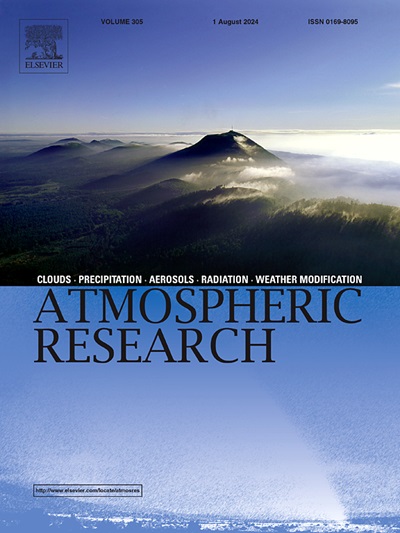Impact of the combined assimilation of GPM/IMGER precipitation and Himawari-8/AHI water vapor radiance on snowfall forecasts using WRF model and 4Dvar system
IF 4.5
2区 地球科学
Q1 METEOROLOGY & ATMOSPHERIC SCIENCES
引用次数: 0
Abstract
In this study, the investigation is made to reveal the impact of multi-strategically assimilating Global Precipitation Measurement (GPM) precipitation and Himawari-8/Advanced Himawari Imager (AHI) water vapor radiances (WVR) on forecasting a heavy snowfall event in the Eastern Qinghai-Tibet Plateau (EQTP) employing the Weather Research and Forecast model (WRF) and the Four-Dimensional Variational (4DVar) assimilation system (WRF-4DVar). The multiple data assimilation (DA) strategies include control tests (CON), the individual assimilation of AHI and GPM tests (DA_AHI and DA_GPM) and the joint assimilation of GPM and AHI (DA_G&A), with different initial times. The results indicate that GPM precipitation effectively captures mesoscale atmospheric details, but its scope is confined to a limited area. AHI WVR is sensitive to upper-middle atmospheric humidity and furnishes extensive-scale environmental parameters such as water vapor transport characteristics. The joint assimilation of the two not only yields multi-dimensional atmospheric insights but also addresses the limitations of individual assimilation. Assimilation GPM and AHI are respective sensitivity to the lower layers (about 800hpa) and upper layers (about 400hpa) of model. The individual assimilation GPM has the greatest effect on near-surface humidity field, and AHI plays a dominant role in the joint assimilation. By assimilating different remote sensing products at different initial times of NWPs, the thermodynamic and dynamic structures are variously reconstructed, leading to the different snowfall scenes. In addition, we further compare the 12-hourly cumulative snowfall with in-situ meteorological station observations. The predictions of snowfall from DA_G&A perform much better with the correlation coefficient (CC) and root-mean-square error (RMSE) 0.36 and 3.14 mm, respectively. As for different initial times of NWPs, the best snowfall forecast is 0600 UTC on October 28, 2022, and the CC is 0.4. Nevertheless, accurately predicting precipitation areas, intensity, and temporal variations remains challenging, particularly for solid precipitation like snowfall. Thus, meticulous consideration of weather process characteristics, observation attributes, and relevant parameter configurations during DA are imperative to enhance the efficiency of observation data utilization.
利用 WRF 模式和 4Dvar 系统合并同化 GPM/IMGER 降水和 Himawari-8/AHI 水汽辐射对降雪预报的影响
本研究利用天气研究与预报模式(WRF)和四维变分同化系统(WRF-4DVar),多策略同化全球降水测量(GPM)降水量和向日葵8号/高级向日葵成像仪(AHI)水汽辐射量(WVR)对青藏高原东部强降雪事件预报的影响。多种数据同化(DA)策略包括控制测试(CON)、AHI 和 GPM 的单独同化测试(DA_AHI 和 DA_GPM)以及 GPM 和 AHI 的联合同化(DA_G&A),初始时间各不相同。结果表明,GPM 降水能有效捕捉中尺度大气细节,但其范围仅限于有限区域。AHI WVR 对中高层大气湿度敏感,并能提供大尺度环境参数,如水汽输送特征。二者的联合同化不仅能产生多维大气洞察力,还能解决单独同化的局限性。同化 GPM 和 AHI 分别对模式的下层(约 800hpa )和上层(约 400hpa )具有敏感性。单个同化 GPM 对近地面湿度场的影响最大,而 AHI 在联合同化中起主导作用。通过在 NWPs 的不同初始时间同化不同的遥感产品,重建了不同的热力学和动力学结构,从而形成了不同的降雪场景。此外,我们还进一步将 12 小时累积降雪量与现场气象站观测数据进行了比较。结果表明,DA_G&A 对降雪量的预测效果更好,相关系数(CC)和均方根误差(RMSE)分别为 0.36 和 3.14 毫米。至于不同初始时间的 NWPs,2022 年 10 月 28 日 0600 UTC 的降雪预报最佳,CC 为 0.4。尽管如此,准确预测降水区域、强度和时间变化仍具有挑战性,尤其是降雪等固体降水。因此,要提高观测数据的利用效率,就必须在数据分析过程中对天气过程特征、观测属性和相关参数配置进行细致的考虑。
本文章由计算机程序翻译,如有差异,请以英文原文为准。
求助全文
约1分钟内获得全文
求助全文
来源期刊

Atmospheric Research
地学-气象与大气科学
CiteScore
9.40
自引率
10.90%
发文量
460
审稿时长
47 days
期刊介绍:
The journal publishes scientific papers (research papers, review articles, letters and notes) dealing with the part of the atmosphere where meteorological events occur. Attention is given to all processes extending from the earth surface to the tropopause, but special emphasis continues to be devoted to the physics of clouds, mesoscale meteorology and air pollution, i.e. atmospheric aerosols; microphysical processes; cloud dynamics and thermodynamics; numerical simulation, climatology, climate change and weather modification.
 求助内容:
求助内容: 应助结果提醒方式:
应助结果提醒方式:


